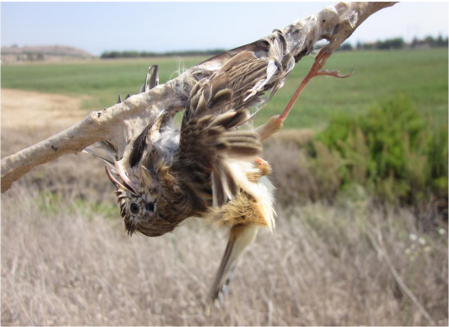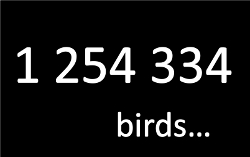Over here on a holiday to coincide with attendance at a family wedding Derek and Cathy McEwan were keen to get a taste of Cypriot wildlife during their stay. We had arranged to help them see as many birds as possible during a hot summer day to satisfy that part of their interests. I picked them up at just after seven from their accommodation in Agia Thekla and we headed straight over to Cape Greco. There we saw a male Cyprus Warbler obligingly sitting on an exposed branch of a juniper bush. The many Spectacled Warbler we could see flitting around the vegetation all over the area would not stay still long enough for good views however. We moved on to the beach near Kermia Hotel where two individuals of our target species, Greater Sandplover, were found – one of them still showing remnants of its breeding plumage. A family of Chukar were climbing over the poly-tunnels while many Crested Lark were also around.

Common Kestrel, ©Jane Stylianou
We drove on to Achna Dam which this year is full of water and we soon saw the resident Coot and Little Grebe. We could hear both Cetti’s and Reed Warbler when two of the latter flew in the reeds close by enabling us to see them. Two Spur-winged Lapwings were located on the opposite bank. Moving to the other side of the Dam we drove closer to the edge. Here we saw several more Spur-winged Lapwings, up to six Little Egrets, two Squacco Heron, a Cattle Egret and several Grey Herons. There were several Common Sandpiper and a Green Sandpiper flew over our heads – early returning autumn migrants already. More surprising was a Eurasian Spoonbill – never common in Cyprus so always a great find. In the distance we could see three terns which we tentatively identified as Whiskered Terns while as we drank our coffee a Gull-billed Tern patrolled and fished the water in front of us. Refreshed we drove away from the Dam only to stop again to watch one of two Hoopoes we had noticed flying around perched on a dead branch of a waterside tree.
Another surprise awaited us at Oroklini Marsh – a Pied Avocet was feeding there with the characteristic sweeping of his upturned bill. He was attracting the attention of the Black-winged Stilts who reacted aggressively towards him – maybe concerned for their young which were nearby. As at Achna there were several Spur-winged Lapwing and well as Coots, Moorhen, Mallard and Little Grebe. More interesting were the female and young Red-crested Pochard on the middle of the lake – proof of a successful breeding season for one of the newest additions to the list of Cyprus’ breeding birds. The Greater Flamingo that had been at Oroklini since the winter was still there so Derek and Cathy could add a bird better known as a winter visitor to their day list.
Larnaca Sewage Works Pools proved disappointing. Derek’s recent leg injury, which precluded him from climbing the steps to the hide, meant that he managed to get good views of Spectacled Warbler flitting in and out of the perimeter fence there, while Cathy and I were unable to add any new species to our day list on the Pools. We drove behind the Pools and found 16 adult Yellow-legged Gull on the dried out salt marsh. A Stone Curlew dashed for cover but we only had a fleeting view of it. Around Spiro’s Pool we found many Crested Lark as well as several Corn Bunting and a juvenile Black-headed Wagtail.
We then drove up to the Troodos range. We stopped at the Livadhi tou Pashas picnic site and had our lunch. As we ate a pair of Masked Shrike were busy in the vicinity and we guessed they must have been feeding young nearby. Derek and Cathy got good views of several Jay – an endemic Cyprus sub-species. The other endemic sub-species, the Coal Tit and Short-toed Treecreeper were not so obliging and only offered fleeting views as they called continually in the area. There were many Barn Swallow, House Martin and Red-rumped Swallow flying across the grassy area taking advantage of the many insects. We moved up to Troodos Square where patient checking of the many Common Swift allowed us to pick out at least four Pallid Swift and we were sure that there were more. There were several Cyprus Wheatear families, many calling Chaffinches and at least one Olivaceous Warbler vying for our attention as we looked down from the car park.
We stopped in an area of vines just outside the village of Omodhos on our way down to the Akrotiri peninsula. A male Black-headed Bunting was sitting on the electricity wires next to the road and as we watched him he was joined by a female and also two juveniles flying amongst the vegetation. Derek’s attention was caught by an unusual insect which he later identified as an Ant-Lion Palpares libelluloides. While he photographed it Cathy and I watched the Buntings and also found a Long-legged Buzzard roosting in a distant tree. A Quail was also heard calling while several Linnets were observed.
At Kensington Cliffs we were treated to a flying display by around thirty Alpine Swift while two Eleonora’s Falcon were hunting in the area. Our final stop was Phassouri Reed Beds where a female Black Francolin ran in front of us as we drove up. Here we were attacked by many small midge-like insects but nevertheless were able to see Squacco Heron again, a Wood Sandpiper and a lovely male Black-headed Wagtail who was feeding on the insects disturbed by the feet of one of the grazing cattle. The sun was setting now so we called it a day and I returned Derek and Cathy to their holiday home. We had seen more species than I had anticipated on a July Cyprus day but it would have been nice if the Coal Tit and Short-toed Treecreeper had been more accommodating!
Full species list
Read More…
Comments Off on Trip Report: Tuesday 5th July 2011
Posted in Birding | Tags: Birding, birds of Cyprus, Cyprus, tours





